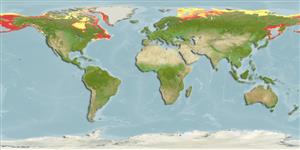>
Perciformes/Zoarcoidei (Eelpouts and pricklebacks) >
Lumpenidae (Eel pricklebacks)
Etymology: Lumpenus: Latin, lumpus, an uncouthlooking spiny-finned fish of a leaden-blue colour (Ref. 45335).
Environment: milieu / climate zone / depth range / distribution range
Ekologi
marina bottenlevande; djupintervall 0 - 235 m (Ref. 50610). Polar; 82°N - 42°N, 33°E - 43°W
Circumpolar. Arctic, North Pacific and Northwest Atlantic: Barents Sea eastward to western Greenland; in the Pacific to southeastern Alaska and to northern Sea of Okhotsk; in western Atlantic to Nova Scotia.
Size / Vikt / Age
Maturity: Lm ? range ? - ? cm
Max length : 36.5 cm NG hane/ej könsbestämd; (Ref. 58426)
Inhabits sandy to rocky bottoms, often in seagrass or algae; rarely, if ever, found in intertidal area (Ref. 51666). Feeds on crustaceans, worms, clams, and fish eggs (Ref. 58426).
Life cycle and mating behavior
Könsmognad | Reproduktion | Lek | Ägg | Fecundity | Larver
Robins, C.R. and G.C. Ray, 1986. A field guide to Atlantic coast fishes of North America. Houghton Mifflin Company, Boston, U.S.A. 354 p. (Ref. 7251)
IUCN Red List Status (Ref. 130435: Version 2024-1)
Threat to humans
Harmless
Human uses
Verktyg
Special reports
Download XML
Internet-källor
Estimates based on models
Preferred temperature (Ref.
123201): -1.6 - 3.8, mean -0.3 °C (based on 2023 cells).
Phylogenetic diversity index (Ref.
82804): PD
50 = 0.6250 [Uniqueness, from 0.5 = low to 2.0 = high].
Bayesian length-weight: a=0.00398 (0.00236 - 0.00672), b=2.80 (2.66 - 2.94), in cm total length, based on LWR estimates for this species & (Sub)family-body (Ref.
93245).
Trofisk nivå (Ref.
69278): 3.3 ±0.37 se; based on food items.
Resiliens (Ref.
120179): Mellan, lägsta populationsfördubblingstid 1,4-4,4 år (Preliminary K or Fecundity.).
Fishing Vulnerability (Ref.
59153): Moderate vulnerability (40 of 100).
